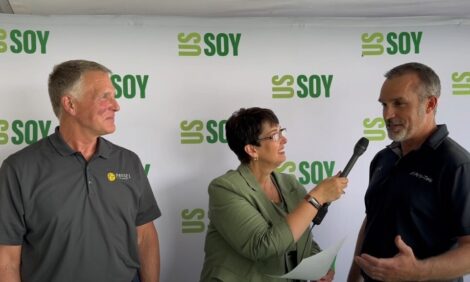



Pork Outlook Report - July 2003
By U.S.D.A., Economic Research Service - This article is an extract from the July 2003: Livestock, Dairy and Poultry Outlook Report, highlighting Global Pork Industry data. The report summizes that total U.S. meat production is to decline slightly in 2003 and 2004.| Overview |
Total U.S. meat production is expected to decline slightly (less than 1 percent) in both 2003 and 2004. Red meat production is expected to decline nearly 2 percent due to the shrinking
inventories of cattle, hogs, and sheep.
The June Quarterly Hogs and Pigs report indicated that producers intend to cutback production in the coming months, but at a lower rate than previously expected. If these intentions are realized, there will be a smaller than previously expected decline in 2004 pork production.
Meat imports are running below previous expectations reflecting the ban on Canadian beef since
May 20. However, the reduction in beef imports from Canada is being partially offset by higher
pork imports.
Meat exports are also running below previous expectations due to reduced beef and
poultry sales to Mexico and weaker poultry sales to Asia.
Cattle price forecasts have been lowered due to anticipated larger-than-previously expected 2003
and 2004 production. Hog price forecast has been raised as strong beef prices supported second quarter hog prices and fourth-quarter prices are forecast higher than previously anticipated.
| June Hogs and Pigs Report in Line With Expectations |
The Quarterly Hogs and Pigs, released June 27th, reported June 1st inventories, farrowing rates, and farrowing intentions that largely track with earlier expectations. If producers’ intentions are realized, annual farrowings and the pig crop for 2003 will be
about 2-percent lower than in 2002. For 2003, continued expectations are for total slaughter of about 99 million head, yielding pork production of 19.5 billion pounds, or, a 1-percent decline, respectively, from 2002.
Lower grain prices and positive producer returns suggest that farrowings, and thus pig crops, may expand marginally next year, but at rates less than 1 percent above 2003. Slaughter next year could be somewhat smaller, given lower farrowings in the second half of 2003 and some increased gilt retention if expectations for continued positive returns are realized. Current expectations point to 2004 pork production of 19.4 billion pounds, a quantity that is
less than 1-percent below 2003 production estimates.
| Live Hog Prices Reflect Lower 2003-2004 Supplies |
Second-quarter 2003 prices of 51-52 percent lean (live equivalent) hogs averaged $42.64 per
hundredweight (cwt), 22 percent higher than a year ago, and 21 percent above prices in this year’s first quarter. On average, 2003 hog prices are expected to be 12 percent higher than in 2002. Next year, prices will average around 8 percent higher than in 2003, or, in the low $40s per cwt. Higher live hog prices both this year and next, reflect lower supplies of hogs and
competing protein animals.
| Lower Retail Prices Expected for Balance of 2003; Higher Next Year |
Retail prices through May averaged more than 3 percent below last year, partly in response to higher than expected pork supplies in the first half of 2003.
Retail pork prices for 2003 are expected to average in the low $2.60s per pound, or, about 1 percent below 2002. Next year, lower supplies of pork and beef will likely support retail pork prices in the upper $2.60s per pound.
| Trade-Side Buoyant: Both Exports and Imports Alike |
In the first 5 months of 2003, U.S. exporters shipped almost 5 percent more pork to foreign markets than in the same period a year ago. Pork exports through May totaled 701.1 million pounds. Although the same three countries --Japan, Mexico, and Canada-- account for the lion’s share of demand for U.S. pork products, market shares so far this year look somewhat different than last year.
| Percent share of U.S. pork exports, January – May | ||
| 2003 | 2002 | |
| Japan | 52 | 51 |
| Mexico | 16 | 20 |
| Canada | 10 | 13 |
| Subtotal, "Big Three" | 78 | 84 |
| South Korea | 6 | 3 |
| Taiwan | 3 | 2 |
| Hong Kong | 2 | 1 |
| Other | 11 | 9 |
So far this year, Japan has imported 9 percent more U.S. pork than over the same period a year ago. Higher Japanese imports are reflected in the 52 percent export share, which is slightly higher than the same-period share in 2002. In fact, Japanese demand for U.S. pork products increased in April, when the Safeguard was rescinded.
The Safeguard is a 25 percent increase in the minimum price of imported pork products, sanctioned by the World Trade Organization (WTO), to protect the domestic Japanese pork industry from import surges.
The effectiveness of the Safeguard has declined in recent years, as import levels tend to be maintained, even when the Safeguard is in effect. Indeed, current expectations are that the Safeguard will be reinstituted later in the fiscal year that began April 1st.
 Several factors will combine to maintain Japanese demand for U.S. pork for the remainder of this year, among them, a lower-valued dollar relative to the currencies of other major pork exporting countries (Canada and Denmark), and likely surges of imported frozen pork, which typically accompanies Safeguard expiration and “run-ups” to any expected Safeguard
re-imposition.
Several factors will combine to maintain Japanese demand for U.S. pork for the remainder of this year, among them, a lower-valued dollar relative to the currencies of other major pork exporting countries (Canada and Denmark), and likely surges of imported frozen pork, which typically accompanies Safeguard expiration and “run-ups” to any expected Safeguard
re-imposition.
The decline in Mexico’s share of U.S. pork exports is significant. Slower economic growth is likely the primary factor contributing to the reduced demand. In the first 5 months of 2003, U.S. exports to Mexico declined 15 percent over the same period last year.
With higher U.S. pork prices expected both this year and in 2004, expectations for growth of U.S. pork exports to Mexico is limited, at least until macroeconomic conditions improve. Another more current market factor is the anti-dumping suit that Mexican pork producers have instituted with the Mexican Government, against several U.S. exporters, and Mexican importers. With the producer action still under review, traders on both sides of the border likely are tempering shipments of U.S. pork products despite the absence of trade restrictions as of January 1, 2003, under the terms of the North American Free Trade Agreement.
 Canada’s share of U.S. exports has also declined, through May. Although it is difficult to precisely identify the factors responsible for the decline, it is likely that higher prices of desirable U.S. cuts, together with the continued expansion of the Canadian pork sector, combine to temper Canadian demand for U.S. pork products.
Canada’s share of U.S. exports has also declined, through May. Although it is difficult to precisely identify the factors responsible for the decline, it is likely that higher prices of desirable U.S. cuts, together with the continued expansion of the Canadian pork sector, combine to temper Canadian demand for U.S. pork products.
Much of the export share lost so far this year by Mexico and Canada, has been picked up by smaller Asian markets: South Korea, Taiwan, and Hong Kong. Income growth likely accounts for some of the increased sales, but the market development efforts of the U.S. pork industry likely play some role in expanding exports in this part of the world.
While the United States has exported more pork so far in 2003, it has imported more, as well. United States pork imports increased 18-percent over the same period last year. Current expectations are for imports to continue to expand this year, with total 2003 imports increasing almost 13 percent above last year.
Imports next year are expected to be about 4 percent higher than in 2003. In addition to the trade flows generated by the ongoing integration of the U.S.- Canadian pork markets, lower U.S. pork production creates “holes” in domestic supplies of some pork cuts. What isn’t produced and supplied domestically, will likely be sourced abroad, exactly what is being observed in the increased product imports from Canada, or from Denmark.
| Live Imports Continue To Expand in 2003: COOL Uncertainties May Limit Exports in 2004 |
USDA/APHIS estimates of Canadian hog imports through June show an increase of almost 9 percent
over the same period last year. Further, APHIS data indicate that about 72 percent of the 3.2 million hogs imported from Canada through June were feeder pigs.
Fewer U.S. imports of Canadian slaughter hogs likely reflect increased slaughter capacity in Canada (particularly in Ontario and Manitoba), as well as higher product imports from Canada. In other words, what isn’t coming down from Canada in the form of live slaughter animals, is being imported from Canada in the form of pork cuts.
Under the 2002 U.S. Farm Act, regulations for a mandatory Country of Origin Labeling (COOL)
program must be promulgated by September 30, 2004. Under the law, for a pork cut to bear a “U.S.
Origin” label in a retail establishment, the pork must be a product of a hog born, raised, and slaughtered in the United States. Consequently, numerous very complex issues are created with respect to feeder pigs imported from Canada, but raised and slaughtered in the United States.
Under the voluntary guidelines for COOL, ground and pork cuts from such hogs would bear labels at retail stating that the cut (or ground product) is a “Product of Canada, Raised and Processed in the United States”. Current hog import estimates for 2004 are below 2003, reflecting uncertainty over potential regulations.
Links
For more information view the full Livestock, Dairy and Poultry Outlook - July 2003 (pdf)Source: Livestock, Dairy and Poultry Outlook - U.S. Department of Agriculture, Economic Research Service - July, 2003







